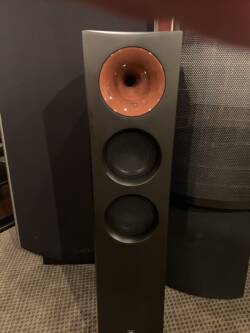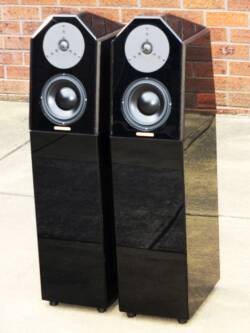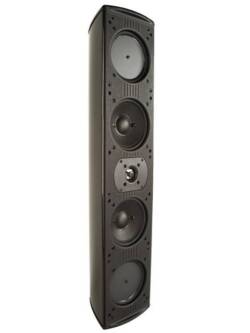Quad 2905 Speakers
Original price was: R180,000.00.R24,000.00Current price is: R24,000.00.
Bottom line. If you understand and can live with the inevitable limitations of an electrostatic speaker, the ESL-2905 offers virtues that no other kind of speaker does.
https://www.audio-occasion.qc.ca/pdf/ESL2905review.pdf
Given certain significant dynamic limitations, it will carry you closer to the absolute sound in truth of timbre, fineness of texture, clarity of line and detail, transient speed, and lifelike presence than most cone loudspeakers (Mini IIs excepted). It is not the ideal speaker for stadium rock, for electronica, for drum-andbass, or for power music of any kind played at
true concert-hall or rock/jazz-club levels. But for the smaller-scale acoustic music that I favor—for chamber, small combo jazz, folk, blues, and much rock—and even for the larger-scale music that I often listen to (albeit played back short of concert-hall volumes on fortissississimos), it is superb. Nothing else plays more realistically at low-to-moderate volumes, regardless of music.
Though not without character of their own, the Quad ESL-2905s are the best electrostatic loudspeakers I’ve yet heard. They immediately join the very small rank of truly great transducers that I’ve auditioned. They are to electrostatic technology what the Magico Mini IIs are to cone technology, the Symposium Acoustics Panoramas to planar-magnetic technology, and the MBL 101 X-Tremes to omni technology—benchmarks. Much as I’d like to own the $30k Mini IIs, the $100k Symposium Pans, or the $200k 101 X-Tremes,
unless I start knocking over gas stations again I’ll never be able to afford either. I could afford the $12k Quad ESL-2905s and can honestly say that, as of this writing, they are the speakers I would buy if I were buying a high-end loudspeaker. For those of you with taste in gear and music like mine, they are must-hears.
Amazing imaging
It’s the sound that sets the 2905s apart: once you get used them, they’re capable of quite amazing stereo-imaging and power. Instruments and voices have a natural ease you just don’t hear from ‘box’ speakers. This fluid clarity extends to the handling of rhythms, and even the most intricate of detail.
The Quads can rock, too – these are far from being speakers only suited to classical and breathy jazz. Their power requirements are modest, 40-100w, and Quad says there’s nothing to be gained from using monster amps. We used Quad’s 99CDP2 CD player/preamp and 909 stereo power amp (£1000 and £900 respectively) to great effect, though we hear whispers there might be even better Quad electronics ‘coming soon’ to make a better match with the 2905s and their smaller bro’s, the 2805s.
The baby ESLs, still over a metre tall, run out of puff at 33Hz – still impressive for an electrostatic design – but do save you £1500. We’d stick with the big boys, however: they’re massive and magnificent, with a sound that attracted praise from everyone, especially our colleagues from Gramophone magazine.
One of them, the owner of a 40-year-old pair of Quad electrostatics, is now trying to work out how he’ll rearrange his house to accommodate the new models. If that isn’t temptation…
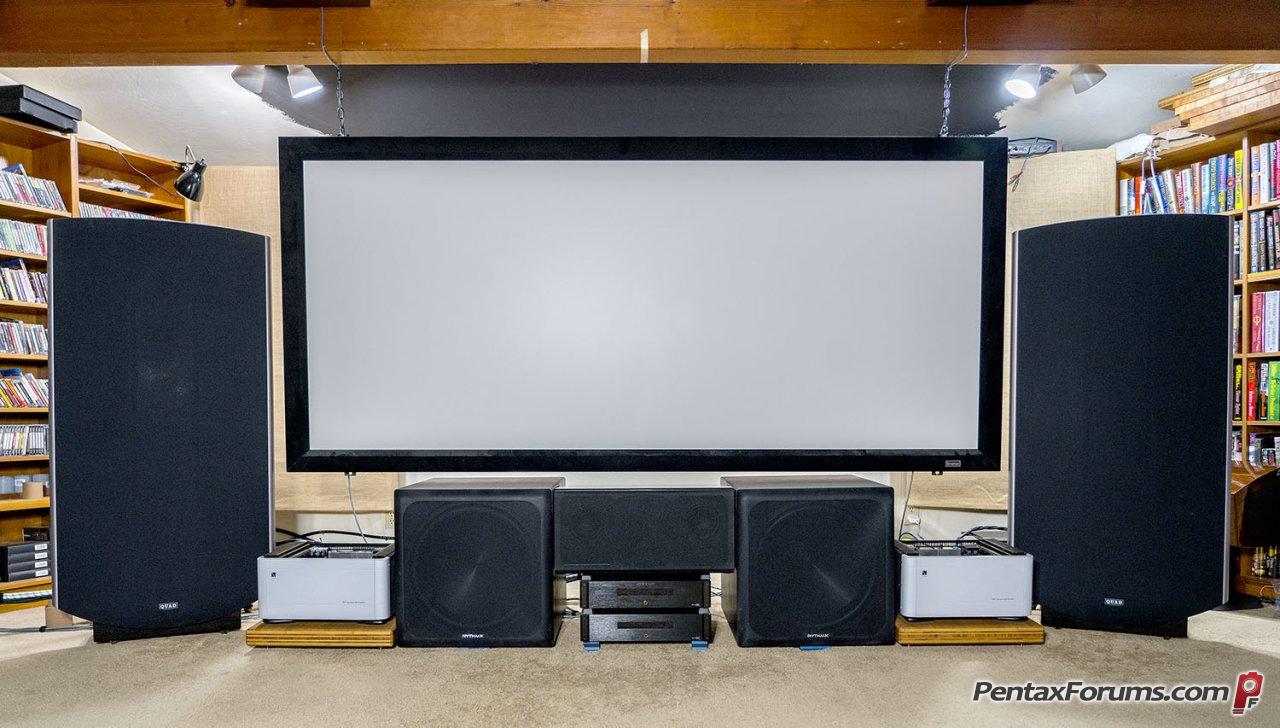
Quad 2905 Electrostatic Loudspeaker
 So why did I think of a Quad system in a search for musical realism in reproducing older CDs and today’s close-milked and over produced recordings? To be honest, I didn’t. Jonathan Valin and Paul Seydor’s reviews of the newer Quad ESLs had captured my attention, and I was looking for a pair of ribbon or electrostatic speakers to serve as a sonic contrast to the Vandersteen 5As I use as a reference. I was also looking for speakers light enough to make moving them practical when I had to adjust a system to review new components. (A problem that made me give up on the massive—but otherwise superb—TAD-1s).
So why did I think of a Quad system in a search for musical realism in reproducing older CDs and today’s close-milked and over produced recordings? To be honest, I didn’t. Jonathan Valin and Paul Seydor’s reviews of the newer Quad ESLs had captured my attention, and I was looking for a pair of ribbon or electrostatic speakers to serve as a sonic contrast to the Vandersteen 5As I use as a reference. I was also looking for speakers light enough to make moving them practical when I had to adjust a system to review new components. (A problem that made me give up on the massive—but otherwise superb—TAD-1s).
I started out by listening to ribbons and taller planers and electrostatics, but height and listening room characteristics made the room a difficult one for the Magneplanar 20.1s and other “tall” planar speakers. I’d been impressed by Jonathan and Paul’s reviews of the new electrostatics, and I’d been impressed by my own earlier listening. As a result, I moved on to the Quad 2905s.
I’m more than glad that I did. I won’t repeat all the details of Jonathan’s excellent review here (TAS, issue 186, November 2008). I would, however, like to reinforce some of his comments and add several notes about how to use the Quad 2905s.
First, let me reinforce the fact that the Quad 2905 is an extraordinarily accurate and realistic speaker with superb midrange performance, very good highs, and extremely accurate bass down to something approaching the deep bass (flat to below 45Hz with pink noise even at average levels of 90dB and useful response to around 31Hz). In fact, I was surprised to find that I could raise the volume to levels louder than I want to hear with the strongest and deepest organ passages on a truly demanding recording like the Jean Guillou performance of Mussorgsky’s Pictures at an Exhibition [Dorian Dor-90117]. A lot of large cone woofers give out or distort sharply on this recording long before the Quad 2905s do.
But, the 2905 is not a “rock speaker,” if rock means super-loud. I don’t want to call it an “acoustic” speaker because it does just fine with reasonable electronic recordings, but ultra-loud is not its natural forte. I also did encounter times when the protection circuits kicked for reasons I could not initially understand, although it turned out that the speakers were actually functioning perfectly. The 2905s sometimes shut down in passages with average listening levels be well below their design limits, which equates to around 103dB in my listening room.
The problem turned out to be that if a recording has massive amounts of deep electronic bass at frequencies you can’t hear, or other really quick peaks that go well above 103dB, the protection circuits will kick in. Be aware that a standard analog Radio Shack SPL meter does not show this. It takes much more professional piece of equipment like the Phonic PM2 to show the real SPL level.
I would note, however, that the Quad 2905 is so clean a speaker that like its very best competition, you can find yourself underestimating the average SPL level. This works well with some music, but not with most acoustic music with significant highs and upper midrange energy. Be careful to keep the music at natural listening levels if you want the most realistic experience. Too little volume and the bass and upper octaves get lost. Too much, and the whole character of brass, woodwinds, and strings tends to brighten in the upper midrange.
 Second, dipoles are no harder to place than other speakers. As Roy Allison pointed out in some pioneering room measurements back in the 1960s, all reasonable listening rooms present serious speaker placement problems for all types of truly full-range speakers. In fact, I found the Quad 2905s surprisingly easy to place, and two to three feet of distance from the rear and sidewalls worked out quite well. I would, however, strongly suggest that you use at least a quarter-octave spectrum analyzer, pink noise, and bass warble tones to place them where they measure well, and then tweak by ear.
Second, dipoles are no harder to place than other speakers. As Roy Allison pointed out in some pioneering room measurements back in the 1960s, all reasonable listening rooms present serious speaker placement problems for all types of truly full-range speakers. In fact, I found the Quad 2905s surprisingly easy to place, and two to three feet of distance from the rear and sidewalls worked out quite well. I would, however, strongly suggest that you use at least a quarter-octave spectrum analyzer, pink noise, and bass warble tones to place them where they measure well, and then tweak by ear.
No one can hear the size and frequency of the peaks and valleys in the lowest octaves. You have to measure them to know what is happening, and inches can matter in getting rid of the worst of them in the range of positions where you listen. This is a concern with all speakers, but your experience with “boxes” may well be misleading with dipoles. You should start with some level of measurement. I use a combination of the Tact 2.2x and the Phonic PM2, but there are many programs that will work on a laptop.
I also would recommend that you try wider spacing and much sharper degrees of toe-in with the 2905s than you would with box speakers, even to the point of aiming the 2905s so each main axis crosses in front of the listening position. These are not yesterday’s Quads. Unlike the Quad 57s that I used in my first real high-end system, the 2905s do a good job of dispersing even the highest frequencies in the real world musical spectrum. Unlike both the Quad 57s and Quad 63s, they don’t need to be raised or stacked to get good vertical dispersion or limit floor and rug effects.
As is the case with most modern and flat speakers, however, their on-axis response can produce too much upper-octave energy if the speaker is aimed directly at the listening position (measures better, sounds worse). Moreover, diploes generally sound better if they are at an angle to the corners, rather than parallel to them, or have some damping to reduce back and side reflections. (This may explain Jonathan’s comments about the occasional spotlighting of female voice. I certainly found it eliminated some emphasis on the upper voice, flute, clarinet, strings, etc.)
The 2905s also proved to be capable of a remarkably realistic three-dimensional sound stage without forcing the listener into a single spot with an unmoving head if they are toed in enough. The realism on a wide range of naturally miked, naturally positioned jazz and chamber music recordings was both extraordinary and stable. Finding the best room location is always is going to be room-specific, but do keep experimenting until you get at least very good results. The 2905s are good with all forms of music, including the most overblown and overproduced opera staging of Wagner, but they can be truly extraordinary in reproducing the soundstage you expect from the kind of solo instrument and small musical ensemble that could actually perform in your home. Don’t waste their capabilities.
Third, the 2905s don’t really need a subwoofer, but don’t be afraid of adding one if you really need the deepest bass or want to push the envelope in terms of listening levels. Using a subwoofer will have costs as well as advantages. Adding cables, using crossover components, and introducing different (i.e., non-electrostatic) drivers does have a slight sonic impact. Ideally, use a preamp with a processor loop. But, be aware that these sonic costs will only have a limited impact on the apparent realism of even the most demanding recordings if you use good subwoofers and associated equipment.
Experimenting with an advanced electronic crossover like the Tact 2.2X is probably the best way to go. However, a REL subwoofer used as a supplement to the 2905s worked fine. So did using the built-in crossovers in Velodyne DD-18, an Outlaw LFM-1, and Definitive Technology Supercube 1 subwoofer.
I got very good results in extending the bass and slightly increasing power handling using such subwoofers. I could push the deepest organ passages to their limits with both, as well as increased realism with deep electronic bass and Kodo drum recordings. I still preferred the Quad 2905s without a subwoofer for music without very deep, high-energy bass content—but not by much. Today’s subwoofers are one hell of a lot better than they have been in the past.
I also found that I could get relatively seamless and nearly flat bass down to around 28Hz using a combination of the 2905s, a Definitive Technology Supercube 1 and the manual adjustments and measurement capabilities of the Velodyne SMS-1 electronic bass unit.5 The SMS-1 is a badly neglected unit in my opinion, and if you have a serious room problem or want flatter bass with minimum grief, it really merits your attention.
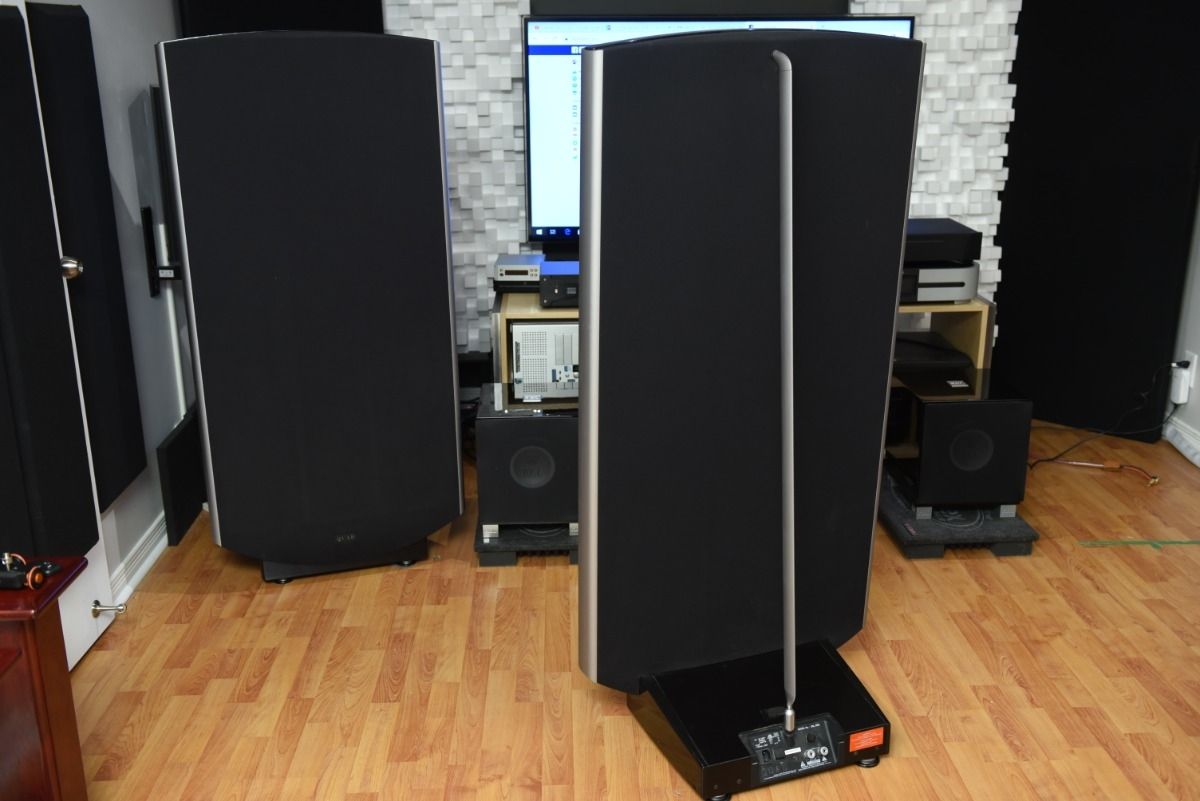
Music with the Quads seems to originate from a point behind the transducers. When the term point source was coined, it must have been while listening to a Quad ESL. This point source is not just radiating middle and high tones. Bass too comes from that one hole in time and space. This is not a given for all electrostatic loudspeakers. Only Quad as far as we know employs concentric rings in the membrane to produce a literal ripple effect for the wave launch.
In the lowest frequency range, something quite remarkable happens. With dynamic drivers, bass response needs space and thus time to build up. Listened to from very close up, a dynamic loudspeaker system often lacks bass. The large membrane of the ESL however can very easy build up enough air pressure to make liquid bass possible from such a position. Bass tones are created with unbelievable ease, without any boom or exaggeration whatsoever. Integration of bass, middle and treble is unique and completely time-coherent. The usable extension to roughly 40Hz is more than enough for most music. The most incredible virtue of the 2905 is cohesion. Bass and treble are almost one. The liquidity of both ranges is equal. The bass is – well, just lower.
The treble at first seems a little modest and shy. It lacks the in-your-face character many tweeters exhibit. On voices however, it has a great sense of naturalness. These 2905s with their mild highs make long listening sessions possible without any fatigue setting in. And with the 2905s, you have to listen long, that’s how addictive it is.
Did we mentioned that the ESLs are fast, very fast? Transients build up instantly and out of nowhere. There is a point of origin that is very pleasing to the brain which isn’t shocked. After the attack, the sustain of the tone is neither warm nor analytic. It simply reveals the timbre of the instrument. At the end, the decay is just like its origin – the tone dies off and back to the point whence it came.
With its wonderfully natural smoothness, its amazing focusing capabilities, its rare time coherence and absentee fatigue factor, the 2905 seems like the ideal loudspeaker. It is, in fact – with a few restrictions.
The ESL 2905 does not like loud music. If you don’t either, you’re in business. At about 98dB/1 meter, the 2905 thinks it’s time to close shop and shut down. As sound pressure builds up towards this 98dB threshold, there’s a terrible sonic fallout at first. It’s like a damaged CD where samples fail. If you ignore these early warnings and fail to immediately turn down the volume, the Quad protection system will taker over and shut you down. Too bad, you’ve played too loud. However, a German magazine documented that using 5 ESLs in a surround setting can produce enough SPLs to blow your mind or eardrums.
When you have a moderately large room of around 40 to 50 sqm (360 to 450 sqf) and think that 90dB is great for listening for hours on end to well recorded music in your favorite listening chair, then your’e a Quaddie. Once you’ve heard a 2905, there’s no further room for controversies. Where Kubrick had his black monolith as the Philosopher’s Stone, we have the 2905 as the Musician’s Stone. Magic time!

STUNNING STUNNING STUNNING !!!! After 5 years of “cone kicking” every nameplate loudspeaker in the universe across 5 countries, I have finally purchased what I never thought I would …. electrostatics !
My wife and I now live in Western Australia but have auditioned many systems over the years in our quest for audio nirvana …… Dynaudio Evidence Temptations (at The Adelphi, Singapore) for ~US$40k, Watt Puppy 7 and 8’s for ~US$27k, the new Jamo 909s for ~US$15k, the new Von Schweikert VR-5SEs for ~US$23k, Eidolon Diamonds for ~US$35k, Martin Logan Odysseys etc etc ….. you name it, we’ve heard it.
Despite each of these speakers having strengths in certain areas, all were aggravating or compromised in some way ……
Dynaudio Evidence Ts: needed power and only came to life at higher volumes (7/10),
Watt Puppy 8’s: still have that tiny sweet spot and that screechy metal dome Focal tweeter that cuts like a knife when you least expect it to (even improved crossovers from the 7s can’t fix that, 8/10),
Eidolons: sometimes sound awefully lean and seem to only come alive with high end high powered Spectral amplifiers (7/10)
VS VR5-SE’s had silky smooth highs because of Scanspeak revelator tweeter but bass seemed somewhat contrived and overdone (8/10)
Sonus Faber Stradivari Homage: As close to perfection as I’ve heard ….. until I heard the 2905s ! (9/10).
….. electrostatics were never even on our radar ….. but the ESL 2905’s have changed everything ….. and I suspect permanently (11/10). They are without doubt the most coherent, transparent, seamless, dynamic, rhythmic and engaging loudspeaker I have ever heard – entirely non-fatiguing despite extended listening sessions with none of that cabinet colouration that seems to plague even the best cabinet speakers for a part of their frequency range. Until we heard the 2905s we were never really aware of cabinet colouration because there were no alternate benchmarks that caused us to question it …… until now.
And get this …… THE 2905s DO BASS ! There is a purity and rightness to it that defies belief. If you want the last 99/100’s of ultimate slam then buy a cabinet speaker but be prepared to accept compromises in every other part of the frequency range. In fact, don’t read my review any further. Everything I want to say about this loudspeaker has been precisely expressed in the UK’s HiFi News magazine (Oct 2006 edition) by Ken Kessler who awarded this speaker a perfect 20/20 score and claimed these to be the best speaker on the planet …. I won’t refute it.
These speakers are so damn human ….. there is texture, there is space, there is separation between instruments, there is rhythm, voices are organic, soundstage is ummm, well ….. eveywhere in front of me. Where do I stop ???? !!!!!
And to think I’m driving these with a small 100W/ch mid-range hybrid integrated amplifier (Vincent SV-236, tube driver / solid state output) makes me wonder what damage these things will do when we strap on US$30k worth of DAC, pre-amp and tube power amp at the front end (were tossing up a tube system … perhaps VTL, VAC, Audio Research or Mcintosh …. not sure yet … will post again at a later stage) ….. my current CD/SACD unit is the Sony SCD-XA777ES (Stereophile Digital Component of the Year 2002 for those interested in “the system”)
It is now close to midnight as I write this and singing for me in my home is Joni Mitchell (Both Sides Now) …. I swear shes in the room ! I have lsitened to these speakers at every opportunity in the past 10 days. I have >100 CDs now littering the floor, but each one now feels somehow new. I’ve discovered a musicality in some CDs that seemed not to exhibit much before. Earlier today Midnight Oil were playing that mind blowing drum solo from “Power and the Passion”, Miles Davis was transporting me with “So What” (Kind of Blue), Keb Mo was doing his thing and BB King had a Bad Case of Love (Blues on the Bayou) …….
There is nothing I’ve been able to throw at these that gems that they’ve not handled with aplomb. Truly, genuinely, utterely stunning
…………. but get the amp right. I think I got lucky with the Vincent – a great match even if only low-end but the amp does trip at high volumes because of the high current draw. Being ESLs with low sensitivity (~80dB) they need decent power for higher volume listening.
Description

SPECIFICATIONS
| Format | Floor standing dipole with 3° fixed tilt black |
| Type | Multiple Electrostatic Drive Membranes |
| Membrane | Ultra Low Mass (0.5gm) Tensioned Film |
| No. of Panel Elements | 6 |
| Time Delay | Progressive Concentric Rings |
| Chassis Structure | Heavy Duty Composite Aluminium / Steel |
| Maximum Output | 2 N/ at 2m on axis |
| Sensitivity | 1.5 mbar per volt referred to 1m (86dB/2.83V RMS equivalent) |
| Impedance | 8 Ohms nominal |
| Impedance Variation | 4 – 20 Ohms |
| Maximum Input | Continuous input voltage (RMS): 10V Programme Peak for undistorted output: 40V Permitted peak input: 55V |
| Frequency Reponse | 37Hz – 21kHz (-6dB) 33Hz – 23kHz (useable) |
| Directivity Index | See Polar Diagrams |
| Distortion (100dB @ 1M) | Above 1000Hz 0.15% Above 100Hz 0.5% Above 50Hz 1.0% |
| Directivity Index | See Polar Diagrams |
| Distortion (100dB @ 1M) | Above 1000Hz 0.15% Above 100Hz 0.5% Above 50Hz 1.0% |
| AC Input | 220 – 240V or 110-120V |
| Power Fuse | 63 mA anti-surge, 200-240V 100 mA anti-surge, 100-120V |
| Power Consumption | 6w |
| Dimension (H × W × D) | 1430 × 695 × 385 (mm) (add 25-55mm for feet) |
| Net Weight | 41.6kg each |




